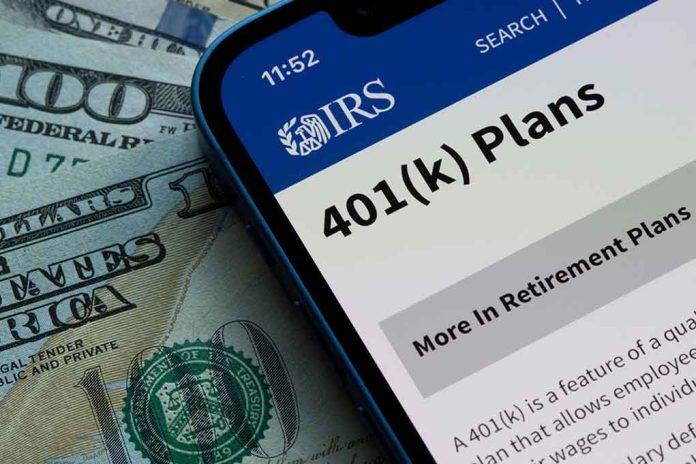
Need a Cash Influx? What To Know About Loans vs 401k Withdrawal
(DailyDig.com) – Borrowing or withdrawing money from your 401k plan may not be the best idea. However, sometimes situations such as a medical emergency or serious illness can force your hand, especially if you’ve run out of other money sources to rely on. Since your 401k promises a comfortable retirement, it’s critical to weigh the risks and benefits of taking money out of the plan.
What Is a 401k Loan?
A 401k loan is simply borrowing against your 401k savings plan, only that you have to pay it back with interest. The upside to this is that the loan and interest payments go back to your account. It is also reliable as most employers’ plans allow you to borrow, provided you meet the set loan rules. Usually, a person can borrow the lesser of $50,000 or 50% of the vested account balance of $100,000 or more. If the account balance is less than $10,000, the amount to borrow is limited to $10,000.
The reasons for borrowing can vary, ranging from paying college tuition, buying a house, or whatever circumstances meet the plan administrator’s approval. The repayment period for most 401k loans is within five years, which are deducted from the paycheck. So, if an individual stops working under a certain employer, they have only 60 days to repay the owed loan amount. If the loan is not paid in full when the timeline elapses, the loan turns into a withdrawal while the outstanding loan balance is treated as a taxable distribution, including a 10% penalty if you’re under 59 1/2 years.
The Pros and Cons of a 401k Loan
Remember, if you take a 401k loan, you have to pay it back with interest. Therefore, it’s vital to consider the pros and cons to avoid long-term financial mistakes.
Pros
- The loan doesn’t attract taxes or early withdrawal penalties if it’s repaid within the set timeline, usually within five years.
- The principal and interest amounts to repay go back to the account owner and not a third-party lender such as a bank.
- The loan approval process is simple as there are no credit history checks or a complex application process.
- In case there’s an urgent financial situation, it is easy and quick to access the loan from the 401k account.
- A 401k loan has a relatively low-interest rate compared to banks or other lenders, which is determined by the plan. Usually, the loan rate is a point or two above the current prime rate.
Cons
- Taking a 401k loan means losing out on the compounded growth of retirement money in the long run.
- Failure to comply with the loan repayment rules attracts penalties and taxes.
- Money borrowed from a 401k is repaid on after-tax dollars that will again be taxed on withdrawals made upon reaching retirement.
- If there is a job loss, the entire loan must be paid within a shorter time frame, typically within 60 days.
- Retirement savings growth may be minimal as part of the contributions goes towards repayment of the loan.
With all things considered, it’s wise to borrow a 401k loan as long as it offers more benefits over risks.
What Are 401k Withdrawals?
With a 401k withdrawal, you’re not required to pay back the amount withdrawn. However, you’ll be charged ordinary income taxes and possibly the 10% penalty fee for withdrawing early before age 59 1/2. If an employer’s plan allows a hardship withdrawal, the 10 % penalty can be forgiven. The IRS provides the safe harbor exception toward someone who qualifies for hardship withdrawal to cover a serious and immediate financial need. This includes:
- Foreclosure or eviction from a primary residence
- Funeral or burial expenses
- Medical expenses
- Payments for tuition
- Purchase and repair of the primary residence
Essentially, it’s vital to check up on the employer’s specifications of what constitutes a hardship withdrawal. Consider also that there are employers who limit contributions to the 401k account after withdrawals are made. You may also qualify for a non-hardship withdrawal under other plans. Overall, taking the loan option to fix your financial needs means reducing money in your account that could be growing tax-free.
Pros and Cons of 401k Withdrawals
If you’re considering making a withdrawal from your 401k, you also need to be familiar with the ramifications.
Pros
- Cash is easily available to cover personal emergencies.
- You don’t have to pay back withdrawals, unlike with a 401k loan.
Cons
- A withdrawal limits the long-term growth of retirement savings as some plans prevent extra contributions for six months.
- A hardship withdrawal is chargeable to federal income tax rates.
- There’s an early withdrawal penalty of 10% if the account owner has not reached 59 1/2 years.
Qualifying for a withdrawal relies on the plan’s rules, including if you have a hardship that is covered by the plan.
Other Alternatives To Consider
Before taking money out of your 401k, you should ensure you’ve looked into all other possible funding sources.
If there’s an emergency fund set aside, this can help wade a person over a difficult time. The general rule of thumb is to save three to six months of living expenses. The fund can grow with as little as $100, and it’s also a good idea to open a high-yield savings account to keep the money.
Another option is for a homeowner to take up a home equity loan against the value of the property. A lender can offer an interest rate of as low as 5.96%; however, this depends on factors such as income, home equity, and credit score.
There’s also withdrawing from Roth IRA, which is both tax and penalty-free if withdrawals are made within a 5-year period. This exception also applies to first-time home purchases, college payments, and birth and adoption costs.
Other options include moving higher interest credit balances to a credit card with a lower interest, or making tax-free withdrawals from a health savings account (HSA) for qualified health and medical expenses.
401k Loan vs. Withdrawal: Which Is the Right Solution?
Generally, both a 401k loan and withdrawal are discouraged and should be taken as the last option. For one reason, you will be losing the benefits of your money growing on compound interest over time. However, if you see no other way out of your predicament, you’re advised to take a loan over a withdrawal.
A 401k loan can be beneficial in the long run if used in the right way. This could be to pay down high-interest debts, medical costs, or college tuition. On top of that, the loan and interest are paid back into the account. The best thing to do is to avoid spending the loan on nonessential expenses such as buying a birthday gift for a family member.
As for a withdrawal, it comes in handy when someone is dealing with unforeseen events. However, the downside is that the retirement savings fail to gain potential returns for a secure retirement.
Final Thoughts
While it’s enticing to access your money from the 401k when you need to, you have to be realistic about how it impacts your retirement future. A 401k is a tax-advantaged account with matching employer contributions and compounding returns. Unfortunately, life happens, and depending on a 401k is understandable. However, it’s far more advantageous to seek a financial planner who can evaluate all the options available just to avoid touching the 401k and allowing it to grow.
Copyright 2022, DailyDig.com













